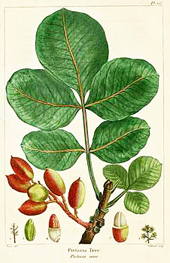Pistachios:
Eating O' the Green
by Audrey Stallsmith

My father was a player in Drury Lane;
Pears and pistachio nuts my mother sold:
He a dramatic poet, she a scold.
"The Man of Taste," Rev. Mr. Bramston
Pistachios are so ancient that they were among the gifts Jacob recommended his sons take to Egypt’s second in command. That premier, of course, turned out to be their missing brother, Joseph.
Understandably still miffed about their selling him into slavery, Joseph probably wouldn’t have considered any gift adequate to the occasion, but pistachios were a good try and a right royal repast. Later, the famous Queen of Sheba hoarded all the ones in her country for herself and her court.
Native to the Middle East and western Asia, Pistacia vera means “true nut.” That’s a lie, as those “nuts” actually are seeds which grow inside beige shells and red husks. Harvesters remove the husks and dry the shells in the sun, until they crack open.
Back when pistachios still were imported from Italy and sold in vending machines—a dozen for a nickel—their shells usually were dyed red to hide stains left by the husks. (We can guess that the "nuts'" high class reputation probably deteriorated somewhat when the consumption of them could turn your lips and tongue red.) These days most U.S.-grown pistachios retain their natural color.
The deciduous trees grow to about 30 feet and require sandy soil and a climate which combines both hot summer temperatures and at least six weeks of winter ones below 45 degrees. In the U. S., pistachios generally only flourish in southwestern desert regions of Zones 8 through 10, i. e., parts of California, Arizona, and New Mexico. They also require both male and female trees for proper pollination.
Both genders produce inconspicuous brownish-green blossoms in early spring, whose pollen rides the wind between trees. After a long hot summer, the “nuts” generally are harvested in early autumn.
Because pistachios contain the same irritating urushiol that poison ivy does, they can cause severe allergic reactions in some people, especially in those also allergic to mangos and cashews. High in fiber and protein, a couple B vitamins and some minerals, pistachios otherwise make a nutritious snack and are sometimes added to Mediterranean cuisine, baked goods, ice creams, etc. They also give a whole new meaning to the idea of eating green!
Pistacia vera image is by P. Bessa from The North American Sylva, Volume 3 by F. A. Michaux, courtesy of plantillustrations.org.








